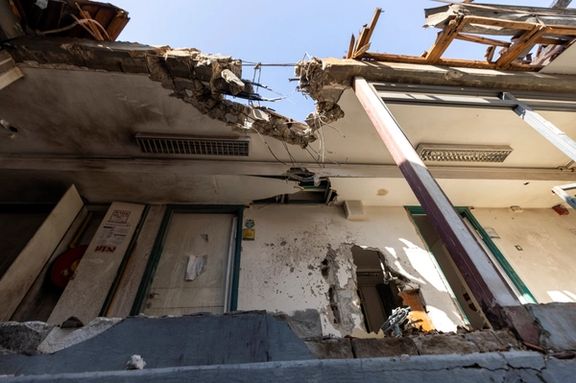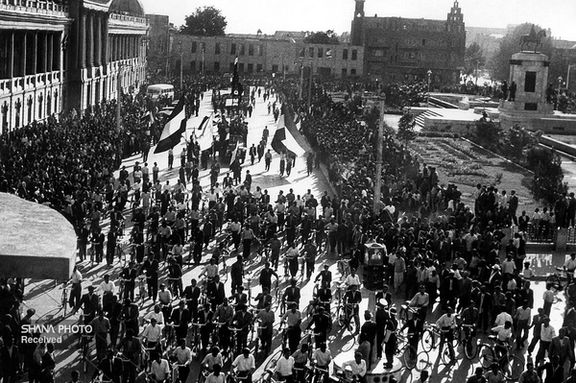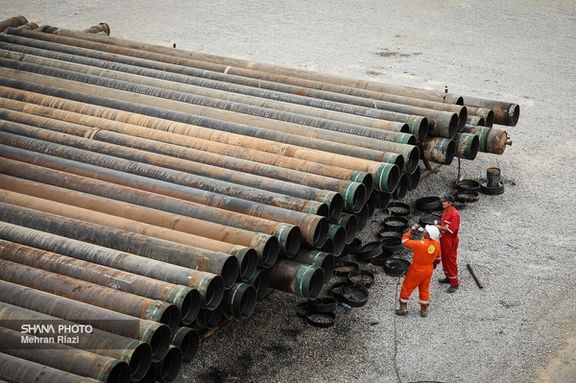Iran’s IRGC Trained 500 Islamist Militants Weeks Before Israel Attack

Iran has trained hundreds of Islamist fighters for combat in the weeks leading up to the attack on Israel, the Wall Street Journal cited intelligence sources as saying.

Iran has trained hundreds of Islamist fighters for combat in the weeks leading up to the attack on Israel, the Wall Street Journal cited intelligence sources as saying.
The WSJ said Wednesday that about 500 members of the militant groups Hamas as well as Palestinian Islamic Jihad received specialized combat training in Iran in September, the people familiar with intelligence related to the assault.
The training was led by officers of the Quds Force, the Revolutionary Guards’ extraterritorial wing, while senior Palestinian officials and Quds Force Commander Brig. Gen. Esmail Qaani also attended the training.
More than 1,400 people, mostly civilians, were killed October 7 by Hamas fighters who poured across the border from the Gaza Strip. Scores of others were kidnapped and taken back to Gaza, where they are being held hostage. Nearly 6,000 Palestinian have died in Israel's retaliatory air campaign.
Iran is not shy about its financial and logistical support for its proxy militias across the region, including Hamas. US officials said Iran has regularly trained militants in Iran and elsewhere, but Washington said it had found no indications of a mass training specifically to prepare for the attack.
“Before the war, Iran directly assisted Hamas with money, training and weapons and technological know-how,” said Rear Adm. Daniel Hagari, the military’s chief spokesman, on Wednesday. “Even now, Iran is helping Hamas with intelligence.”
Earlier in the month, the Journal cited senior Hamas and Hezbollah officials as saying that the Quds Force helped plan the attack and agreed that it could go ahead at a meeting in Beirut on October 2 with leaders of Hamas and Hezbollah. An adviser to the Syrian government and a European official gave the same account of Iran’s involvement.

The Iranian regime is planning to hand over the oil industry to the “private sector,” which will effectively place the national wealth in the hands of insiders.
In 1951, the Iranian parliament seized control of the country’s oil industry which had been run by private companies, largely controlled by the British. The movement that led to the legislation was led by Mohammad Mosaddegh, a populist lawmaker who became Iran’s prime minister a year later. The legislation led to the nationalization of the Anglo-Iranian Oil Company, a British firm founded in 1909 following the discovery of a large oil field in Khuzestan province and the first to extract petroleum in Iran.
According to an article in reformist daily HamMihan on Tuesday titled “Transitioning Beyond Oil Nationalization” the government, in its Seventh Development Plan, seeks to hand over the rights for exploration, development, extraction, production, and exports of oil and gas to the private sector. It practically means that the government no longer regards oil and gas reserves as the assets of the nation but views it as its own property, and has decided to transfer the rights to the National Development Fund (NDF) that later can sell rights or ownership to domestic entities.
More than 80 percent of Iran's economy is controlled by the clerical regime, including the Revolutionary Guard, leaving little room for real businessmen or private companies to flourish.

The administration of President Ebrahim Raisi submitted the country’s Seventh Development Plan to the parliament last month. After lawmakers refused to approve Raisi’s initial plan apparently for being too general and vague, the administration practically extended its expired development plan for the third time since 2021 with a few amendments and called it a new plan. The old document, the 6th Development Plan, was to be implemented between 2016 and 2021, but many parts of it have remained untouched as the government lacked the appropriate resources due to a catalogue of foreign policy and economic problems. If approved by the parliament, two provisions of the new plan authorize the government to facilitate the delegation of contracts in the oil industry.
According to the amendments, it is stipulated that "the government is allowed to sign contracts (with third parties) on exploration, development, extraction, production, sale, and export at oil and gas fields via the Oil Ministry to settle its debts to the NFD, without transferring their sovereignty.”
Warning of the consequences of such a move, HamMihan said the main concerns are not limited to the act of transferring the national rights to the private sector, but the fact that the country’s oil and gas industry will end up at the hands of quasi-state organizations and institutions controlled by regime insiders. Based on the experience from similar measures, the entities that truly represent the private sector lack the capability and resources needed to handle such big projects, the daily said. It argues that semi-governmental or semi-public firms (called Khosoulati in Persian) will be the ones that would eventually take control over the fields. Khosulati is portmanteau word made from fusing two Persian adjectives for “private” and “governmental” and refers to companies that are sold to the private sector on the surface, but are owned by the government, IRGC-linked entities, regime’s bigwigs or entities under the control of the Supreme Leader.
The sanctions imposed on Tehran and the country’s murky regulations and shady oil exports make it extremely difficult – if not impossible – to attract foreign investors, who would fear US reprisal and punitive measures in case of entering the country’s oil and gas market.
Pundit Mohammad Mashinchian told Iran International that Iran’s oil and gas industry is in dire need of infrastructural investment and the NDF was meant to achieve that but failed like many other good ideas in the Islamic Republic. He described the latest decision as a “coup de grâce to the initial idea” of the fund. Highlighting Iran’s corrupted oil economy, he said the sanctions serve as a pretext to giving control of the country’s exports to the authorities’ close circles. “This is laundering Iran’s national wealth into the hands of the regime’s circles of power,” he noted.

Washington has communicated a potential shift in its stance regarding Iranian assets held in Qatari banks and postponed talks on nuclear issues.
The message was allegedly delivered by Secretary of State Antony Blinken during his visit to Doha on October 13, according to Amwaj Media.
The delay is suspected to be driven by the tensions surrounding the war waged by Iran-backed terror group Hamas on October 7 against Israel when thousands of its militia slaughtered at least 1,400 civilians and soldiers and took at least 220 more hostage.
Since then, attacks have taken place on US bases in Iraq and Syria, with Iran's Yemen proxy, the Houthis, also sending missiles towards Israel since the war broke out, intercepted by the US and Saudi Arabia.
According to Amwaj Media, a source denied the war in Gaza was to blame for the postponement.
In August, Tehran and Washington struck a deal that led to the liberation of five American hostages held in Iran, in exchange for the release of $6 billion in frozen Iranian assets located in South Korea. These Iranian assets were first transferred to Switzerland's central bank for conversion before being subsequently moved to Iranian bank accounts based in Qatar.
The United States has made itself clear in its desire for Iran to stay out of the Israel-Hamas conflict and warned it to control its Lebanon proxy, Hezbollah. It has also pledged its commitment to support Israel as it vows to rid the Gaza Strip of the terror group designated by the US, EU and UK.
As of the time of this publication, the US State Department has not issued an official statement regarding the developments.

Amir-Arsalan Ejdehakosh, a 15-year-old protester arrested last year, hanged himself on the anniversary of his detention, Iran International has learned.
Ejdehakosh was detained for two months during the protests which followed the death in morality police custody of Mahsa Amini and committed suicide on October 7.
During his two months in detention, he endured both physical and psychological torture. His ordeal included sleep deprivation and recurring nightmares after his release as a result of the torment he suffered while in custody.
Amir-Arsalan was not only a young protester but also a passionate fan of rap music. Before his arrest, he had been working on an experimental piece of music, a project he was unable to complete due to his incarceration.
Since the initial wave of protests following Mahsa Amini's death, nearly 20,000 Iranians were arrested by regime agents during or between protest rounds. While many were released, a few have met mysterious and untimely deaths.
Among them, in November, was the case of Arshia Emamgholizadeh, a 16-year-old who was arrested in East Azarbaijan province for tossing the turban of a cleric. He spent ten days in detention before being released on bail, but two days later, he tragically took his own life. Arshia had confided in friends about the use of unknown pills administered by prison authorities.
Some medical experts have raised concerns that the administration of drugs to certain prisoners may have inadvertently resulted in addiction, which exacerbated their mental health issues upon release.

An Iranian artist arrested during the Women, Life, Freedom protests has spoken of the severe torture she endured in custody.
Now in exile in Turkey after fleeing Iran, Elham Modarresi was arrested last November on charges such as vandalism of facilities, anti-government propaganda, disrupting public order and inciting people to kill.
In January, rights activists Hengaw told of her hunger strike while imprisoned at Karaj's Kachoui prison. During her detention, the artist originally from Kurdish province Sanandaj, was deprived of the right to access a lawyer as well as her case, and she also suffered from liver and intestinal disease, the group said.
In her latest update from Turkey, Modarresi revealed that during her imprisonment, she was subjected to severe physical torture, including brutal beatings that led to internal bleeding.
Minority Kurdish Iranians have historically been treated with extreme oppression under the regime, as a recent report revealed at length.
The artist was temporarily released from Karaj's Kachoui prison on January 22, with bail posted, allowing her to escape.
In a message shared on the X network, Modarresi said, "12 Iranian security agents stormed our house, violently pushed my mother, put handguns against my mother and brother's heads, blindfolded me, and took me away."
She spoke of how intelligence officers destroyed her ultrasound records, concealing the abuse, and the recurrent threats of sexual violence, part of systematic state sanctioned sexual violence well documented by Iran's Me Too movement.
Throughout her time in prison, Modarresi was denied access to medication and medical care as the regime pressured her into a forced confession.
She now faces an uncertain future with no guarantees of safety in Turkey and has pleaded for help to find refuge.

An official on Sunday told the parliament that immigrants in Iran number over 8 million despite interior minister’s much lower figure of five million last month.
Interior minister Ahmad Vahidi had reported this lower figure on September 27, stating that there were "around five million Afghans in Iran." However, Mohsen Najafikhah provided a substantially higher estimate of 8.4 million immigrants.
Afghans, often referred to simply as ‘foreign nationals’ by officials and the media, make up the majority of immigrants in Iran. The census of 2016 found the presence of over 1.5 million Afghans followed by 34,500 Iraqis and 14,320 Pakistanis.
“The question is whether the number of foreign nationals in the country has increased since [September] or the statistics offered by the interior minister was not right,” Faraz Daily news website asked Monday.
Afghans first came to Iran as refugees in early 1980s and later as economic migrants but before the Taliban takeover of the government in Afghanistan in 2021 their numbers rarely rose above two million. Around 780,000 had obtained refugee status and were not considered illegals.

In April 2022, Javad Hedayati, the director general of the International Transit Bureau of the Transportation Organization, reported a significant increase in the number of Afghans entering Iran through official borders since the Taliban takeover. He stated that the number had risen to as many as 5,000, compared to the previous range of 700-800. Notably, there were no available statistics on the number of illegal immigrants.
The government has not taken any steps to slow down the deluge of refugees, leading to accusations that the clerical regime might have sinister plans to use the Afghans, who speak Persian, for political or military aims.
In late September, a member of the parliament’s National Security and Foreign Policy Committee, Mahmoud Ahmadi-Bighash, disclosed plans to grant Iranian citizenship to legal Afghan immigrants. Ahmadi-Bighash claimed they number between eight to ten million.
According to Ahmadi-Bighash, a former governor of the northeastern North Khorasan Province, the primary aim of the plan is “population transfer” and legalizing the presence of millions of Afghan immigrants.
Referring to the parliament’s approval of a bill to establish a “national immigration organization” in November 2022, he claimed that those behind the plan want to “facilitate the entry and residence” of Afghan citizens.
In recent weeks, the government’s political rivals have repeatedly warned about its “open borders” policy and the possibility of hidden agenda with hardliners responding to such criticism by accusing critics of inciting “Afghan-phobia” amid fast-growing anti-Afghan sentiments on social media and violence against the immigrants.
Some government critics claim authorities are actively encouraging the growth of the Afghan population with incentives such as subsidized energy and food to remedy the problem of population decline or even to bolster its military by recruiting young Shiite Hazara Afghans.
During the Sunday session, lawmakers assigned the interior ministry the task of establishing a national immigration organization in collaboration with the Secretariat of the Supreme National Security Council.
The government claims that by forming such an organization it will be able to “systematize” the data on foreign nationals’ entry, exit and expulsion for which, according to Najafikhah, ten different government departments are currently responsible.
Government’s critics allege that the plan may be a cover for naturalizing Afghans in Iran. “A national immigration organization, if formed, can easily turn into an organization for issuing residence permits,” Faraz Daily’s report said.
The report pointed out that the government bill includes provisions for offering a series of services – including access to national insurance and benefits – to foreign nationals without citation of allocated budget.
“It is not clear whether the country’s economy is capable of offering these services to so many immigrants, just the same as it is still not clear how many of the 8.4 million are legal immigrants and how many are illegal (undocumented),” the report said.